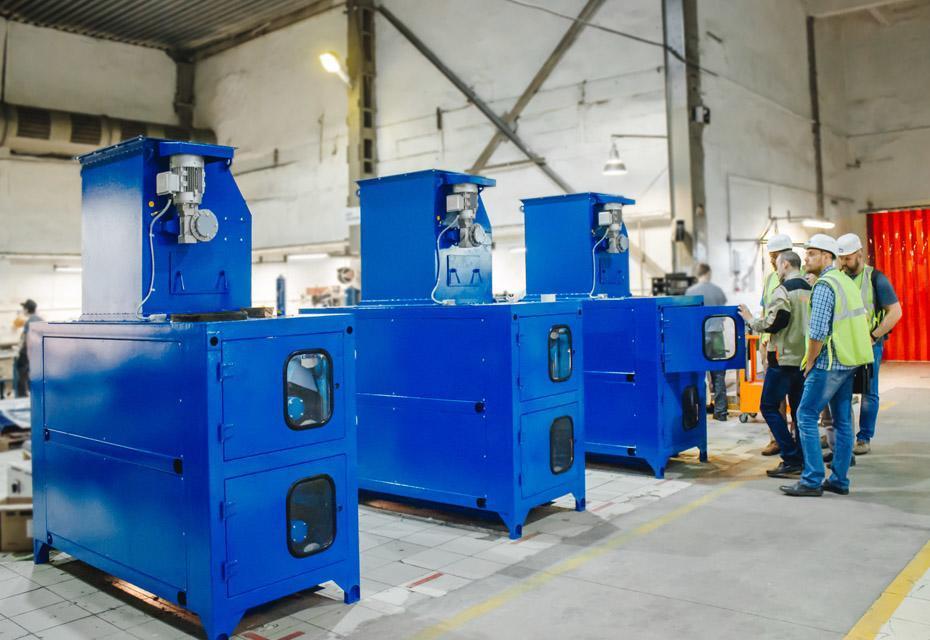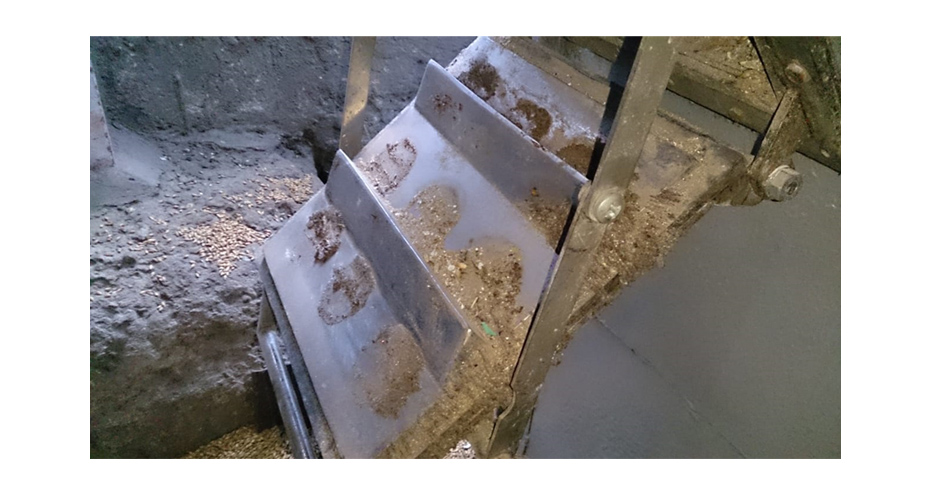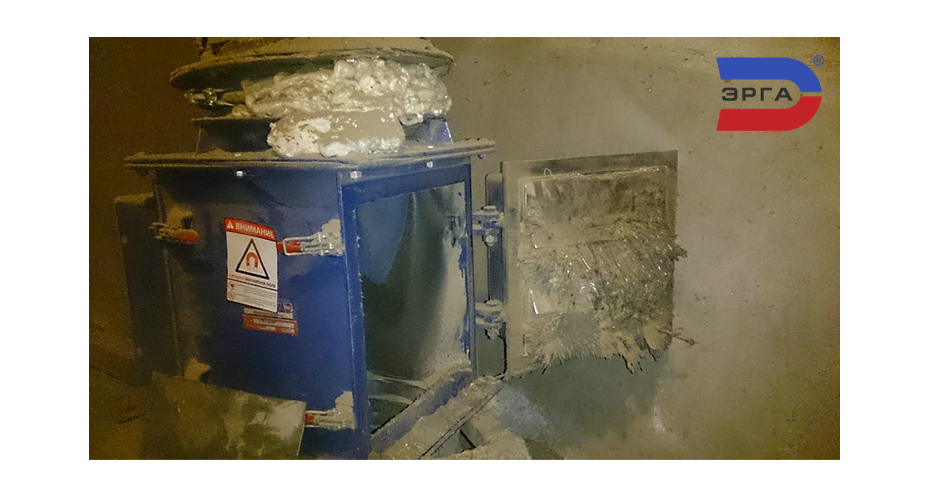How to select a magnetic separator?
- #Recommendations

Magnetic Separator Efficiency Criteria
Magnetic separator efficiency criteria depend on the task at hand.
- For iron separators it is important to achieve maximum percentage of extraction of impurities of a certain size that can harm or damage crushing, grinding or other equipment. Taking into account the operating conditions (height of the product layer on the belt, conveyor speed), a separator model that can remove the required dimensions is selected.
- Separators recovering saleable magnetic fraction in the form of scrap metal, iron ore concentrates, dense medium solids, ferroalloys, etc., must ensure the required content of the valuable component in the separated product. It means that the quality of magnetic separator operation with removal of non-magnetic impurities, host rock, slag, will affect the quality and cost of the finished product.
- Another criterion for evaluating how effective this type operates is the loss of a valuable product with a nonmagnetic fraction (tailings). It is often impossible to avoid losses of magnetic material completely due to variability of conditions and material composition, but a properly selected separator will reduce this indicator to minimum values.
For example, if ERGA WetMag R wet magnetic separator for dense media recovery operates correctly, losses of dense medium solids will be only 0.5 g per liter of the processed suspension.
Properties, composition of the separated product and operating conditions
When choosing a magnetic separator, it is also necessary to take into account properties, composition of the separated product and its operating conditions:
1. Product size
The separator type of and its overall characteristics are selected considering the product size. Maximum product size can reach 400 mm, minimum size is 20-10 microns. For processing lumpy material separators with increased safety margin are selected (ERGA DrumMag C, ERGA DrumMag M), for dry separation of finely dispersed products special enclosed designs have been developed to reduce sticking on operating surfaces, as well as losses and carryover of nonmagnetic material (ERGA SMVA, ERGA DrumMag DM).
2. Product temperature
Magnetic system alloy is selected depending on the temperature of material. Standard permanent rare earth magnets have operating temperature up to 60° C. For separation of material from 60° C to 200° C, Nd-Fe-B alloys with dysprosium and terbium are used. Magnet alloy based on Sm-Co is used or higher temperatures up to 300° C.
3. Product moisture
For dry magnetic separation moisture content of the separated product is an important factor. This indicator for the product size less than 10 mm should not exceed 5%, for the product size less than 1 mm - 0.5%, for the product size less than 0.1 mm - 0.1%. At high moisture quality of separation decreases due to adhesion and sticking of particles to the separator surface; therefore, it is recommended to pre-dry the material.
4. Magnetic susceptibility of particles
Magnetic induction in the operating area is selected depending on magnetic susceptibility of the particles. For ferromagnets, separators with low intensity of magnetic field (up to 0.32 T) are installed, for paramagnets, depending on the task, separators with average (0.32-0.9 T) and high intensity of magnetic field (0.9-1.5 T) are installed.
5. Content of magnetic impurities
Percentage of magnetic impurities and inclusions will determine the type of separator cleaning. With low content (less than 0.5%) separators with manual cleaning can be installed. With increased content of 0.5-5%, it is recommended to use mechanical cleaning - this will save operator's time on the process of preparing the equipment for separation. The content of magnetic impurities more than 5% in the product leads to rapid blockage of the operating area and requires continuous or periodic automatic cleaning.
Caution! Tricks of mala fide manufacturers
Due to availability of Chinese magnetic materials the number of manufacturers is increasing, unfortunately, unlike the quality of the produced separators. In pursuit of superprofits manufacturers who do not have proper experience in manufacture and design of magnetic equipment often neglect such necessary conditions as control of the production process, manufactured parts, magnetic characteristics. Below are the most common cases when such manufacturers save on the quality of equipment, and, therefore, on separation efficiency, for the sake of short lead time and low cost.
1. Use of separate magnets instead of magnetic systems
The most common case of reducing costs and shortening the equipment manufacturing time is installation of separately located magnets instead of a complex assembly of magnetic systems that requires special technology and equipment. Saving on magnetic material the conditions of technical specifications are observed, for example, induction on the separator surface, but the magnetic flux and long-range action are significantly lost. Installation of magnets without calculating the pole pitch, with large gaps, leads to distortions in the magnetic field in the direction of the product movement, which increases the possibility of magnetic fraction getting into pure product.
The photo below shows one of the examples of the consequences of equipment cost reduction, where the amount of extracted impurities without the magnetic system is clearly visible.

Fig.1 Use of primitive magnetic disks. The magnetic plate thickness is not more than 3 cm.
- ERGA not only assembles complex magnetic systems, but also calculates and selects magnetic characteristics individually, for almost every task and separation conditions.

Fig. 2 Use of a highly efficient magnetic system on the example of ERGA separator. The magnetic plate thickness is 8 cm.
2. Application of cheap alloys of magnetic materials
Special operating conditions, for example, high material temperature, require installation of expensive high-temperature alloys containing rare-earth alloying elements and a more complex manufacturing process.
Another important characteristic of a permanent magnet is its coercive force - this is the value of magnetic intensity required to completely demagnetize the magnetic material, which is especially important for high intensity separators. Cheaper low-coercivity alloys are easily demagnetized and have low service life.
Often, manufacturers neglect this factor and use cheaper permanent magnet alloys, which leads to gradual demagnetization and loss of magnetic characteristics, therefore, decrease of the separation quality.
- ERGA specialists select the magnetic system material according to technical specifications, install alloys with a temperature and coercive margin and give a 10-year guarantee for the retention of magnetic properties. Magnetic separators of our production, installed 20 years ago, are successfully operated today. Reviews and testimonials from our customers are an objective evidence of this.
3. Neglect of construction safety margin, low-quality components
Almost all separators have wear parts that are usually in direct contact with the product. How long the equipment parts will be serve depends on how competently and accurately the design calculation is carried out and the necessary safety margin is set. Saving on construction material leads to rapid wear (1-2 months) of the drum shells of separators, vibrating feeders, tubes of rod separators, etc. For example, if the metal used for the housing of SMTP series separators operating under pressure is obviously thinner, then when the separator is pressurized, the housing is quickly deformed or damaged.
Such cheaper components as geared motors, bearings, vibrators, frequency converters, help to reduce the cost of the separator, but have low service life.
The lack of a serious design study of the Customer's specifications can be a problem in the delivery of complex equipment, that’s why ERGA design bureau has a department for calculating strength, a department for calculating magnetic systems. This ensures accurate calculation of magnetic fields for non-standard, specific magnetic systems, as well as to design welded joints, pressure vessels, vibration equipment, etc. with greater reliability.
- ERGA uses only proven and high-quality components (bearings, gear motors, belts, non-magnetic materials), so the reliability of our equipment meets the level of leading German and American manufacturers.
4. Ignoring quality control of manufactured equipment
Saving on expensive measuring equipment, absence of test stands for testing characteristics leads to decrease in cost and reduction in the production time of magnetic separators, but contributes nothing to production of high-quality equipment.
- ERGA has such accepted measuring tools as hysteresisgraph, webermeter, teslameter, X-ray fluorescence analyzer to control magnetic characteristics of permanent magnets, magnetic systems and material composition. Our company also operates a testing laboratory for testing ready products. After manufacturing, each product is tested for compliance with the requirements of technical specifications, testing for strength, geometric, process parameters, visual control, separation quality is checked. The testing laboratory is equipped with its own test stands, equipment and tools that enable analyzing product quality. If there are any doubts about the product quality, improvement is made. Thus, high-quality operation of equipment with the Customer's material is ensured.
Often, even having all the information about magnetic separators, separation material, operating conditions, it is practically impossible to select a magnetic separator properly with reliable obtaining the result required for the Customer. Only tests on different types of equipment solve the problem of proper selection of the required magnetic separator, taking into account individual characteristics of the product. ERGA Laboratory for Research of Mineral and Industrial Raw Materials, which presents both laboratory and industrial models of magnetic, electrostatic, gravity, air separators and metal detectors produced by the company, provides our Customers with the opportunity to evaluate the efficiency of the proposed equipment in practice.